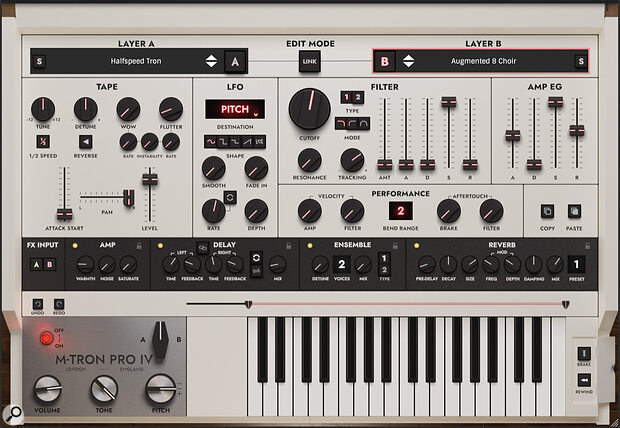GForce’s software Mellotron just keeps getting better.
So, you already manufacture what many feel to be the pre‑eminent Mellotron emulation, yet you feel that it’s time to update and extend it, offering your customers more than before and, let’s be honest, making a few extra shekels at the same time. But how? Happily, GForce’s developers must have found answers that they liked because I now have in front of me two M‑Trons — the original M‑Tron Pro running on an Intel Mac, and the latest M‑Tron Pro IV — now compatible with Apple Silicon — running on an M1 Pro. (Don’t worry, it’s PC‑compatible too.)
New Tricks
The new version looks very different from the original, and there’s no doubt that its scalable GUI is an improvement. The Mellotron‑y bits are more Mellotron‑y, and the modern features look and feel more, umm... modern. Sure, many of its capabilities are the same as before, but a closer look shows that there are several updates and additions. The new wow and flutter controls allow you to age the instrument in ways that we hated in the 1970s, the LFO has been augmented, there’s a second filter family, there’s a second aftertouch destination, the key range has been extended by seven semitones, and the effects section has been enhanced to include an amp emulator, an improved ensemble and a reverb section. Despite all of these additions, I find the GUI and its associated patch manager to be clearer and easier to use than before. What’s more, the M‑Tron Pro IV no longer suffers from the fake coffee stains of previous versions. What’s not to like?
The Mellotron’s character has been maintained even after tidying up some of the more wayward notes on the original tapes.
A Mellotron is at heart a sample player so, as well as its enhanced synthesis and effects, the M‑Tron Pro IV has an enormous underlying library. This ranges from instantly recognisable Mellotron MkII and M400 strings, brasses, flutes and choirs, through numerous MkII rhythm tapes and M300 tapes, many lesser‑known Mellotron sounds, Birotrons, Chamberlins and, perhaps of most interest to aficionados, obscuria rescued from custom tapes recorded for bands as diverse as Black Sabbath and Tangerine Dream. The review copy was also supplied with four free expansion packs: ChamberTron Extras, Compute‑a‑Tune, Piano Bass 2 and Isolation Choir 2020, all of which include interesting and potentially useful sounds. Obviously, none of this would matter if the results were bland or uninspiring, but the sound quality is great, the Mellotron’s character has been maintained even after tidying up some of the more wayward notes on the original tapes, and looped versions of many sounds are available in case you want to sidestep the Mellotron’s eight‑second limitation.
Conclusion
All of this will be of little interest if your desire for Mellotron sounds is confined to the ‘Strawberry Fields’ flutes, the three violins that almost single‑handedly defined prog rock, and dead men singing. There are many alternatives for these and, while the M‑Tron Pro IV and its predecessors sound more authentic, I’ve been using samplers and workstations to play these sounds on stage for more than three decades. ‘Careful With That Axe Eugene’ played on a Roland XP‑80? It sounds like sacrilege, but you would be surprised! However, if your ambitions extend beyond the more famous Mellotron sounds, M‑Tron Pro IV’s huge library and updated synthesis/effects engine allows you to go much further. Perhaps it doesn’t have the heft and authority of my Mellotron MkII (or indeed, GForce’s own M‑Tron MkII soft synth), but I suspect that it’s still the most widely useful recreation of almost all things Mellotron‑y, and now even more so.
Summary
Probably the leading Mellotron soft synth — now much improved and even more encompassing than before.

